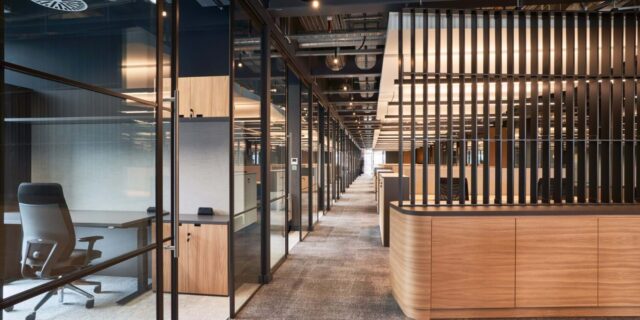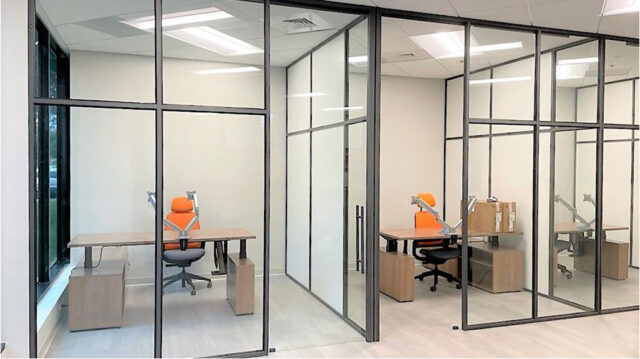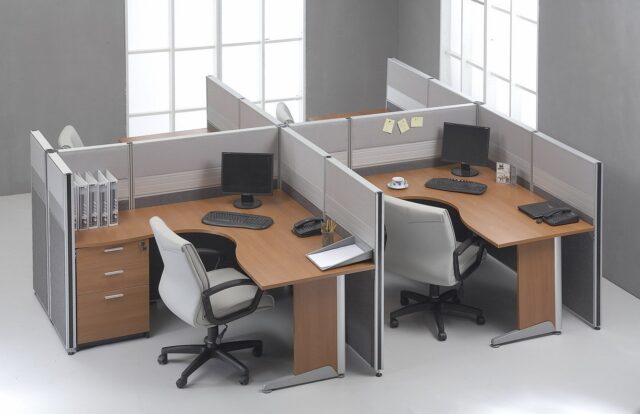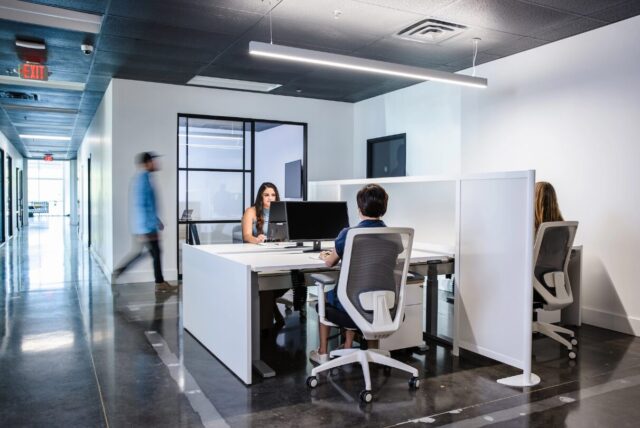
Office partitions, often overlooked, play an instrumental role in shaping the dynamics of our work environments. More than just dividers, they help optimize space, infuse character, and maintain a balanced workflow. As workplaces become more multifaceted, the focus on space management intensifies.
These partitions contribute not just to physical division but also to a company’s ethos, promoting collaboration while ensuring individual privacy. With urban spaces shrinking and the value of every square foot increasing, mastering effective space utilization becomes not just a design consideration, but a business imperative.
The Evolution of Office Spaces
Tracing back the roots of office design, the transformation is evident. There was a time when individual rooms and closed doors dominated the corporate landscape, signaling hierarchy and inaccessibility. This gradually gave way to cubicles, aiming to democratize workspace yet often criticized for their maze-like, isolating nature. The new millennium saw a revolt against these boxed spaces, championing open offices.
While these open layouts were a breath of fresh air, emphasizing transparency and teamwork, they inadvertently introduced new challenges: noise pollution, lack of personal space, and frequent distractions. The evolving office landscape thus paints a picture of our consistent quest for the ‘perfect’ balance—spaces that foster community, yet respect individuality.
The Role of Office Partitions

Office wall partitions have emerged as an ingenious solution to these ever-evolving challenges. More than just dividers, they are dynamic tools that shape how we interact, work, and even think. In today’s modern workplaces, they’re far from one-size-fits-all. Partitions offer a duality—providing open spaces for spontaneous collaborations, while ensuring secluded spots for those demanding tasks that require laser focus. They’ve transcended from being mere physical barriers to design elements that weave functionality with aesthetics. Their significance can’t be overstated as they pivotally influence office energy, flow, and productivity.
Types of Office Partitions
The world of office partitions is diverse and tailored to fit the unique requirements of different work environments. Glass separators stand out for their sleek design, ushering in transparency and fostering an atmosphere of inclusivity. They allow natural light to permeate spaces, eliminating the often dreaded office gloom. Then we have modular panels, offering versatility and easy adaptability.
They can be moved, adjusted, or reconfigured with changing needs, ensuring the office landscape remains fluid. Last, but certainly not least, are acoustic dividers. In an age where distractions are rife, these partitions prioritize sound control, ensuring conversations remain private and ambient noise is reduced. Each type has its distinct advantages, catering to varied office dynamics and cultures.
Advantages of Glass Partitions
Glass partitions are not just about aesthetic appeal; they are emblematic of a modern, progressive work culture. By allowing an uninterrupted flow of natural light, they not only reduce dependence on artificial lighting but also enhance mood and boost productivity. Studies have shown that exposure to natural light improves employee well-being and efficiency.
Furthermore, glass separators offer an unparalleled blend of privacy and openness. While they delineate spaces, they avoid creating a claustrophobic environment. Their sound control capabilities, especially when double-glazed, further add to their growing appeal in contemporary offices.
Maximizing Privacy and Productivity

Contrary to the perception that partitions might ‘box in’ employees, they, in fact, play a crucial role in elevating productivity. In a world rife with digital distractions, having a dedicated, private space can immensely boost concentration. Partitions help create these personalized zones where employees can work undisturbed, free from the humdrum of office chatter. Strategic separator placement can lead to improved workflow, reducing unnecessary movement and interruptions. Beyond just physical barriers, they act as psychological cues, signaling when someone is in ‘deep work’ mode and shouldn’t be disturbed.
Creating Collaborative Spaces
Office partitions are not just about individual focus; they are equally adept at crafting collaborative zones. By creating semi-open spaces or designated huddle areas, partitions foster team interaction without letting conversations disturb the entire office. They help strike a delicate balance, ensuring that while individual tasks aren’t hampered, the spirit of collaboration remains alive. The dynamic nature of today’s projects demands both—focused individual effort and cohesive teamwork. Partitions play a pivotal role in ensuring both these facets flourish.
Customization Options
The beauty of modern office partitions lies in their adaptability. Gone are the days of one-size-fits-all solutions. Today, businesses can customize separators to mirror their ethos, brand colors, and design sensibilities. From frosted glass designs that add a touch of elegance to branded modular panels that resonate with company values, the possibilities are endless. They can be tailored to reflect company culture, making the workspace a living embodiment of brand identity.
Sustainability and Office Partitions

With businesses becoming increasingly conscious of their ecological footprint, the choice of office partitions is no longer just about design or functionality. Modern separators are crafted with sustainability in mind. Materials are chosen not just for their longevity but also for their eco-friendliness. Recycled materials, energy-efficient processes, and the emphasis on reducing waste have become standard practices in separator manufacturing. This alignment with corporate responsibility further cements their place in modern office design.
Case Studies
Around the world, several forward-thinking companies have seamlessly integrated office partitions into their workspaces. Tech giants, startups, and traditional firms alike have harnessed their potential. For instance, a renowned software company in Silicon Valley uses clear glass separators adorned with minimalistic designs to foster openness while ensuring team discussions remain private. On the other side of the spectrum, a publishing house in London employs wooden acoustic dividers, creating cozy nooks for writers, blending tradition with modern needs.
Future Trends
As remote work gains traction and hybrid models become commonplace, office partitions will likely evolve in tandem. We might see innovations aimed at creating more flexible, mobile partitions, catering to a workforce that’s not always in the office. Smart partitions equipped with technology, offering features like digital displays or soundproofing on-demand, could be the next big thing. As the lines between home and office blur, separators might find relevance even in home offices, ensuring work-life boundaries even within the confines of one’s home.
Conclusion
Office partitions, far from being mundane, are at the forefront of shaping the future of workspaces. They embody the balance modern work demands—collaboration and privacy, aesthetics and functionality, tradition and innovation. As businesses evolve, these partitions stand as adaptable allies, ensuring workspaces remain optimized, productive, and relevant. It’s an exciting era for office design, and partitions, undoubtedly, are at its heart.









